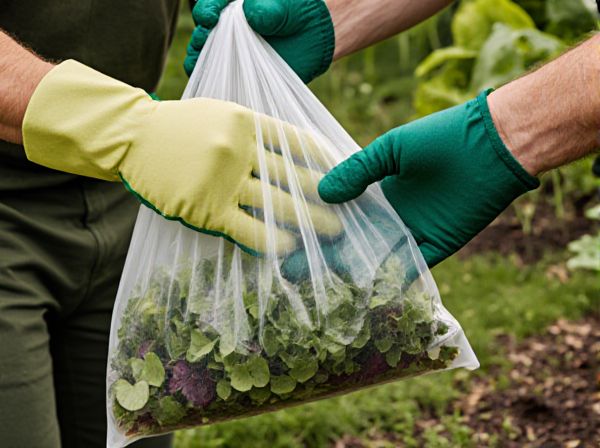
Grow bags vs rigid containers Illustration
Grow bags offer superior aeration and root pruning compared to rigid containers, promoting healthier plant growth and preventing root circling. They are lightweight, flexible, and easy to store when not in use, making them ideal for limited space gardening. However, rigid containers provide better durability, stability, and water retention, making them suitable for long-term planting and larger plants.
Table of Comparison
| Feature | Grow Bags | Rigid Containers |
|---|---|---|
| Material | Breathable fabric | Plastic, ceramic, or metal |
| Drainage | Excellent, air-permeable | Depends on holes, can cause waterlogging |
| Root Health | Prevents root circling, promotes air pruning | Risk of root circling and compaction |
| Portability | Lightweight and foldable | Heavier, rigid structure |
| Durability | Moderate, may degrade in sunlight | High, long-lasting |
| Cost | Generally lower | Typically higher |
| Ideal Use | Vegetables, annual plants | Perennials, ornamental plants |
Introduction: Understanding Grow Bags and Rigid Containers
Grow bags are flexible, breathable containers made from fabric, allowing air pruning of roots and improved aeration, which promotes healthier plant development. Rigid containers, typically made from plastic, ceramic, or metal, provide sturdy support and retain moisture longer but may restrict airflow to the root zone. Choosing between grow bags and rigid containers depends on factors like plant type, watering habits, and the need for portability or durability in gardening.
Material Differences: Fabric vs Plastic/Clay
Grow bags are made from breathable fabric materials that promote air pruning of roots and enhance oxygen flow, leading to healthier root development and reduced risk of root rot. Rigid containers, typically constructed from plastic or clay, offer more durability and moisture retention but can limit aeration, potentially causing waterlogging and root circling. The choice between fabric and rigid materials significantly impacts plant growth due to differences in breathability, water drainage, and root environment.
Drainage and Aeration: Which Performs Better?
Grow bags offer superior drainage and aeration compared to rigid containers due to their breathable fabric construction, which allows excess water to escape and air to reach the roots. Rigid containers often retain moisture, increasing the risk of root rot and poor oxygenation. Choosing grow bags enhances root health and prevents waterlogging, making them optimal for container gardening.
Root Health: Pruning vs Circling
Grow bags promote healthier root systems as their breathable fabric allows air pruning, which prevents root circling and encourages the development of fibrous roots. Rigid containers often lead to root circling, where roots grow in circular patterns along the container walls, potentially restricting nutrient uptake and plant stability. Air pruning in grow bags enhances oxygen availability and root branching, improving overall plant vigor compared to rigid containers.
Portability and Storage: Moving and Storing Options
Grow bags offer superior portability and ease of storage compared to rigid containers due to their lightweight and collapsible design. Their flexible material allows for convenient folding and compact storage when not in use, making them ideal for seasonal gardening or limited space environments. In contrast, rigid containers are bulkier and require more storage space, but provide stable structure and durability for long-term use.
Durability and Longevity: Lifespan Comparison
Grow bags, typically made from breathable fabric, offer moderate durability with a lifespan ranging from 2 to 4 years before degrading due to exposure to sun and water. Rigid containers constructed from plastic, ceramic, or resin demonstrate superior longevity, often lasting over 5 to 10 years without significant wear. The choice between grow bags and rigid containers largely depends on the balance between portability and the long-term investment in container durability.
Watering Needs and Retention
Grow bags provide superior drainage and air circulation compared to rigid containers, reducing the risk of overwatering and root rot. Rigid containers tend to retain water longer due to their solid sides, which can lead to slower drying and potential waterlogging if not monitored carefully. Plants in grow bags generally require more frequent watering but benefit from improved oxygenation, promoting healthier root systems.
Space Efficiency for Small Gardens
Grow bags maximize space efficiency in small gardens by conforming to irregular shapes and stacking easily, unlike rigid containers that require fixed placement. The flexible nature of grow bags allows for better root aeration and prevents soil compaction, promoting healthier plant growth in limited areas. Lightweight and portable, grow bags can be rearranged effortlessly to optimize sunlight exposure and garden layout.
Cost Analysis: Initial and Long-term Investment
Grow bags typically have a lower initial cost compared to rigid containers, making them an affordable option for budget-conscious gardeners. Over time, rigid containers may represent a higher investment due to durability and reusability, reducing the need for frequent replacement. Cost analysis favors grow bags for short-term use, while rigid containers offer greater long-term value through longevity and structural stability.
Best Uses: Matching Containers to Plant Types
Grow bags provide excellent aeration and drainage, making them ideal for root vegetables like carrots and potatoes that require loose soil for expansion. Rigid containers retain moisture longer and support heavier plants such as tomatoes and peppers, which benefit from stable root systems and less frequent watering. Selecting the right container depends on the plant's root growth habits and water requirements to ensure optimal health and yield.
Grow bags vs rigid containers Infographic

 gardendif.com
gardendif.com